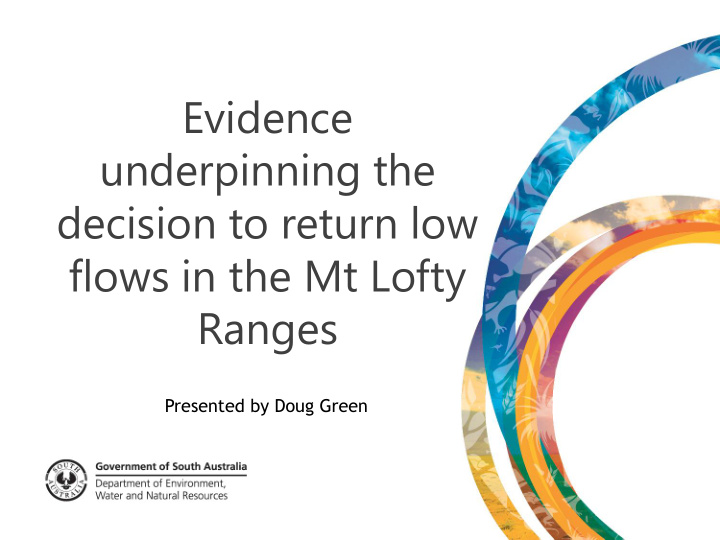



Evidence underpinning the decision to return low flows in the Mt Lofty Ranges Presented by Doug Green
Water Allocation Planning • Water Allocation Plans (WAPs) need to address the needs of Water Dependent Ecosystems (WDEs) • Environmental water requirements (EWRs) inform the environmental water provisions (EWPs) • EWPs developed to maintain WDEs at an acceptable level of risk
Round 1 Jason VanLaarhoven and Mardi van der Wielen (2009-2012) • EWRs characterised by hydrological metrics • Hydrological modelling used to assess number of metrics passing • Number of metrics passing related to fish and waterbug community condition • Scenario modelling used to link scenario → passing metrics → WDE condition
Round 1 Jason VanLaarhoven and Mardi van der Wielen (2009-2012) • Acceptable level of risk = 85% metrics passing
Round 1 Jason VanLaarhoven and Mardi van der Wielen (2009-2012) • Scenario without low flows showed maximum allocation 5% resource capacity • Current development ~15-20% on average
Round 1 Jason VanLaarhoven and Mardi van der Wielen (2009-2012) • Scenario with low flows showed maximum allocation 20-25% resource capacity. • Same water allocations – healthier WDEs
Round 2 Doug Green and others (2013-2014) • Using data to derive ecological response • Ecological monitoring has been undertaken under various monitoring programs • Flow data is collected at flow monitoring stations • Possible to link the two
Round 2 Doug Green and others (2013-2014) • Fish data from EMLR used • Several monitoring sites located at, or in close proximity to flow gauges • Response modelling undertaken using several techniques
180 160 140 120 Median Riffle Flow Days Riffle Flow Days 100 80 Modelled Riffle Flow Days 60 40 20 0 0-8 9-29 30-59 60-115 116-231 232+ Estimated Number of Recruits
Round 2 Doug Green and others (2013-2014) • Deviation Index
0.8 0.7 0.6 0.5 0.4 0.3 0.2 0.1 0 Current Water Current Water 15% Allocation 25% Allocation Full Allocation 15% Allocation 25% Allocation Current Water Dam Capacity Dam Capacity Full Allocation Low Flow Scenarios Not Low Flow Scenarios Use with TFR Use with TFR with TFR with TFR with TFR Use Reduction by Reduction by on all Dams on all Dams 30% 15% >10ML >10ML
Round 3 Maxwell and others 2014-2016 • Goyder Water Allocation Planning Project • Focused on ecological response to changes in intermittency • Used trait groups to characterise changes in community composition and function • Used empirical data to develop models
Round 4 (Deane et al. 2016) • International Literature Review • Common problem across Mediterranean climates • Conclusions – Increase habitat availability – More complex food webs – Macroinvertebrates and Fish respond to wetter conditions – Vegetation should improve (decrease in terrestrials in channel) – Results will vary
Recommend
More recommend